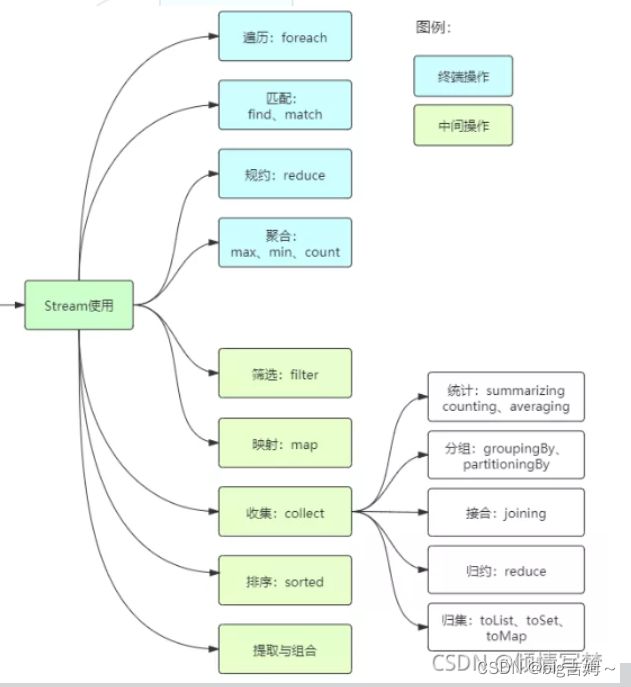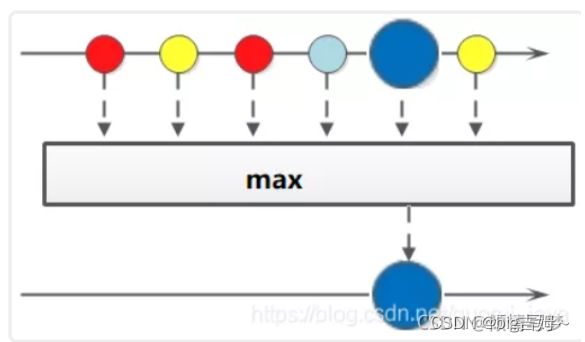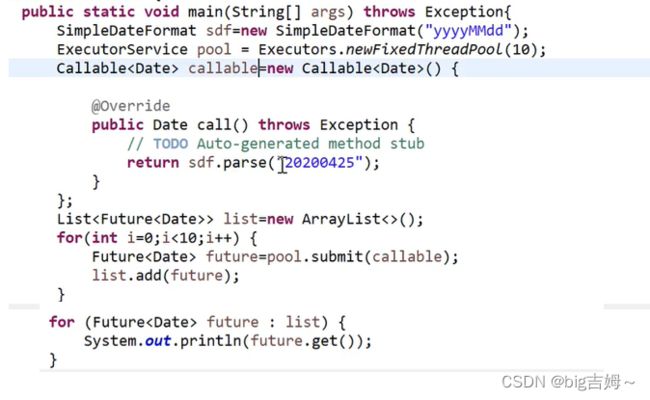JAVA高级篇--Stream流
1.方法应用
对象方法引用: 类名::实例方法. (参数1,参数2)->参数1.实例方法(参数2)
package com.lpt.demo01;
import java.util.function.BiFunction;
import java.util.function.Function;
import java.util.function.Supplier;
public class Test01 {
public static void main(String[] args) {
// Function function=(str)->{
// return str.length();
// };
// Function function=String::length;
// Integer l = function.apply("hello");
// System.out.println(l);
// BiFunction booleanBiFunction=(t,u)->{
// return t.equals(u);
// };
// Boolean apply = booleanBiFunction.apply("hello", "world");
// System.out.println(apply);
// Supplier supplier=()->{
// return new String("hello");
// };
//Function function=(n)->new People(n);
Function function=People::new;
People people = function.apply("hello");
System.out.println(people);
}
}
class People{
private String name;
public People() {
}
public People(String name) {
this.name = name;
}
@Override
public String toString() {
return "People{" +
"name='" + name + '\'' +
'}';
}
} 2.Stream流
Java8的两个重大改变,一个是Lambda表达式,另一个就是本节要讲的Stream API表达式。==Stream 是Java8中处理集合的关键抽象概念==,它可以对集合进行非常复杂的查找、过滤、筛选等操作.
2.1 为什么使用Stream流
当我们需要对集合中的元素进行操作的时候,除了必需的添加、删除、获取外,最典型的就是集合遍历。我们来体验 集合操作数据的弊端,需求如下:
一个ArrayList集合中存储有以下数据:
需求:1.拿到所有姓张的 2.拿到名字长度为3个字的 3.打印这些数据
代码如下:
public class My {
public static void main(String[] args) {
// 一个ArrayList集合中存储有以下数据:张无忌,周芷若,赵敏,张强,张三丰
// 需求:1.拿到所有姓张的 2.拿到名字长度为3个字的 3.打印这些数据
ArrayList list = new ArrayList<>();
Collections.addAll(list, "张无忌", "周芷若", "赵敏", "张强", "张三丰");
// 1.拿到所有姓张的
ArrayList zhangList = new ArrayList<>(); // {"张无忌", "张强", "张三丰"}
for (String name : list) {
if (name.startsWith("张")) {
zhangList.add(name);
}
}
// 2.拿到名字长度为3个字的
ArrayList threeList = new ArrayList<>(); // {"张无忌", "张三丰"}
for (String name : zhangList) {
if (name.length() == 3) {
threeList.add(name);
}
}
// 3.打印这些数据
for (String name : threeList) {
System.out.println(name);
}
}
} 分析:
这段代码中含有三个循环,每一个作用不同:
首先筛选所有姓张的人;
然后筛选名字有三个字的人;
最后进行对结果进行打印输出。
每当我们需要对集合中的元素进行操作的时候,总是需要进行循环、循环、再循环。这是理所当然的么?不是。循环 是做事情的方式,而不是目的。每个需求都要循环一次,还要搞一个新集合来装数据,如果希望再次遍历,只能再使 用另一个循环从头开始。
那Stream能给我们带来怎样更加优雅的写法呢?
Stream的更优写法
public class Test {
public static void main(String[] args) {
ArrayList list = new ArrayList<>();
Collections.addAll(list, "张无忌", "周芷若", "赵敏", "张强", "张三丰","何线程");
list.stream()
.filter(item->item.startsWith("张"))
.filter(item->item.length()==3)
.forEach(item-> System.out.println(item));
}
}
2.2Stream流的原理
注意:Stream和IO流(InputStream/OutputStream)没有任何关系,请暂时忘记对传统IO流的固有印象!
Stream流式思想类似于工厂车间的“生产流水线”,Stream流不是一种==数据结构==,==不保存数据==,而是对数据进行==加工 处理==。Stream可以看作是流水线上的一个工序。在流水线上,通过多个工序让一个原材料加工成一个商品。
Stream不存在数据,只对数据进行加工处理。
2.3如何获取Stream流对象
package com.lpt.demo02;
import java.util.ArrayList;
import java.util.Arrays;
import java.util.List;
import java.util.stream.IntStream;
import java.util.stream.LongStream;
import java.util.stream.Stream;
public class Test03 {
public static void main(String[] args) {
List list = new ArrayList<>();
list.add("刘德华");
list.add("张学友");
list.add("郭富城");
list.add("黎明");
Stream stream = list.stream();
//通过Arrays数组工具类获取Stream对象
int[] arr={3,4,5,63,2,34};
IntStream stream1 = Arrays.stream(arr);
//使用Stream类中of方法
Stream stream2 = Stream.of("hello", "world", "spring", "java");
//LongStream
LongStream range = LongStream.range(1, 10);
//上面都是获取的串行流。还可以获取并行流。如果流中的数据量足够大,并行流可以加快处速度。
Stream stringStream = list.parallelStream();
//
// stringStream.forEach(item-> System.out.println(item));
stringStream.forEach(System.out::println);
}
}
2.4 Stream流中常见的api
中间操作api: 一个操作的中间链,对数据源的数据进行操作。而这种操作的返回类型还是一个Stream对象。
终止操作api: 一个终止操作,执行中间操作链,并产生结果,返回类型不在是Stream流对象。
(1)filter / foreach / count
static List personList = new ArrayList();
private static void initPerson() {
personList.add(new Person("张三", 8, 3000));
personList.add(new Person("李四", 18, 5000));
personList.add(new Person("王五", 28, 7000));
personList.add(new Person("孙六", 38, 9000));
}
class Person {
private String name;
private Integer age;
private String country;
private char sex;
public Person(String name, Integer age, String country, char sex) {
this.name = name;
this.age = age;
this.country = country;
this.sex = sex;
}
}
List personList = new ArrayList<>();
personList.add(new Person("欧阳雪",18,"中国",'F'));
personList.add(new Person("Tom",24,"美国",'M'));
personList.add(new Person("Harley",22,"英国",'F'));
personList.add(new Person("向天笑",20,"中国",'M'));
personList.add(new Person("李康",22,"中国",'M'));
personList.add(new Person("小梅",20,"中国",'F'));
personList.add(new Person("何雪",21,"中国",'F'));
personList.add(new Person("李康",22,"中国",'M')); (2) map | sorted
map--接收Lambda,将元素转换成其他形式或提取信息。接收一个函数作为参数,该函数会被应用到每个元素上,并将其映射成一个新的元素。
//对流中元素排序
personList.stream()
.sorted((o1,o2)->o1.getAge()-o2.getAge())
.forEach(System.out::println);
//集合中每个元素只要名.map--->原来流中每个元素转换为另一种格式。
// personList.stream()
// .map(item->{
// Map m=new HashMap<>();
// m.put("name",item.getName());
// m.put("age",item.getAge());
// return m;
// })
// .forEach(System.out::println); (3) min max
获取员工中年龄最大的人
//查找最大年龄的人. max终止操作 Optionalmax = personList.stream().max((o1, o2) -> o1.getAge() - o2.getAge()); System.out.println(max.get());
(4)规约reduce
//求集合中所有人的年龄和。
Optional reduce = personList.stream()
.map(item -> item.getAge())
.reduce((a, b) -> a + b);
System.out.println(reduce.get());
Integer reduce = personList.stream()
.map(item -> item.getAge())
.reduce(10, (a, b) -> a + b);
System.out.println(reduce); (5)collect搜集 match find
//findFirst match
// Optional first = personList.parallelStream().filter(item -> item.getSex() == 'F').findAny();
boolean b = personList.parallelStream().filter(item -> item.getSex() == 'F').noneMatch(item -> item.getAge() >= 20);
System.out.println(b);
//搜集方法 collect 它属于终止方法
//年龄大于20且性别为M
// List collect = personList.stream()
// .filter(item -> item.getAge() > 20)
// .filter(item -> item.getSex() == 'M')
// .collect(Collectors.toList());
//
// System.out.println(collect); 3. 新增了日期时间类
旧的日期时间的缺点:
设计比较乱: Date日期在java.util和java.sql也有,而且它的时间格式转换类在java.text包。
线程不安全。
新增类:
LocalDate: 表示日期类。yyyy-MM-dd
LocalTime: 表示时间类。 HH:mm:ss
LocalDateTime: 表示日期时间类 yyyy-MM-dd t HH:mm:ss sss
DatetimeFormatter:日期时间格式转换类。
Instant: 时间戳类。
Duration: 用于计算两个日期类
package com.lpt.demo03;
import java.time.Duration;
import java.time.LocalDate;
import java.time.LocalDateTime;
import java.time.LocalTime;
import java.time.format.DateTimeFormatter;
public class Test05 {
public static void main(String[] args) {
LocalDate now = LocalDate.now();
LocalDate of = LocalDate.of(2000, 1, 18);
// System.out.println(now);
// System.out.println(of);
LocalTime now1 = LocalTime.now();
LocalTime of1 = LocalTime.of(20, 4, 40);
// System.out.println(now1);
// System.out.println(of1);
LocalDateTime now2 = LocalDateTime.now();
LocalDateTime of2 = LocalDateTime.of(2000,1,18,20,6,50);
Duration between = Duration.between(of2,now2);
System.out.println(between.toDays());
DateTimeFormatter dateTimeFormatter=DateTimeFormatter.ofPattern("yyyy-MM-dd");
LocalDate parse = LocalDate.parse("1999-12-12", dateTimeFormatter);//把字符串转换为日期格式
String format = parse.format(dateTimeFormatter);
System.out.println(format);
}
}






